#nor does he subscribe to traditional gender roles
Note
She drove her knee into his groin before walking out of the gravity chamber. "This is the reason whs I learned martial arts: to protect myself from idiots like you who think they have power over the female species!"

Sensing the woman's unwanted intrusion and impending attack, he dodged the knee handily. " What are you talking about? I don't care what you did or why you did it. Do you want a fucking cookie or something? Go bother someone who cares. "
#.:ask:.#// vegeta ♅#LMAO OMGGGG#i wasn't going to answer this becuase you obviously ignored what i said#but the last bit fucking sent me#you really think vegeta is sexist???#incredible#as a saiyan he is very equal opportunity when it comes to sex and gender#i.e. he's going to treat men and women and everything in between the exact same#nor does he subscribe to traditional gender roles#man thinks he's better than pretty much everyone#but honey. it's not because you're a woman. I can tell you that much 🤣🤣#also like he's not a martial artist and he can be a dirty fighter#not so much these days but#he knows any self-respecting fighter of any creed or practice isn't going to go for the groin#so if you wanted him to respect you as even a fighter#you fucked that up pal
12 notes
·
View notes
Text
Whenever I discuss Sleeping Beauty with someone who doesn’t share my enthusiasm for Disney, they have an irksome tendency to get it muddled with Snow White; their excuse being “it has the same plot”. I’ll admit, there are some surface similarities that even the most casual viewer can pick up on: a fairytale where a princess is forced into unconsciousness and wakes up with some necking, the comic relief and villain being the most beloved characters, a little frolic in the forest with animals, the antagonist plunging off a cliff, you get the idea. In fact, Sleeping Beauty even reuses some discarded story beats from Snow White, mainly our couple dancing on a cloud and the villain capturing the prince to prevent him from waking his princess. Yet despite that, Snow White and Sleeping Beauty are two wholly different movies shaped by the era and talents of the time.
I’ve discussed how Walt Disney was never one to stick to a repeated formula, no matter how successful it was. He must have noticed the parallels between his first movie and this one, but decided to make one crucial change for Sleeping Beauty that would forever differentiate the two: the look. We all know the traditional Disney house style: round, soft shapes, big eyes; charming as it was and still is, Walt was sick of it after several decades. Meanwhile, artists like Mary Blair and Eyvind Earle were producing gorgeous concept art that rarely made a perfect translation into the Disney house style.
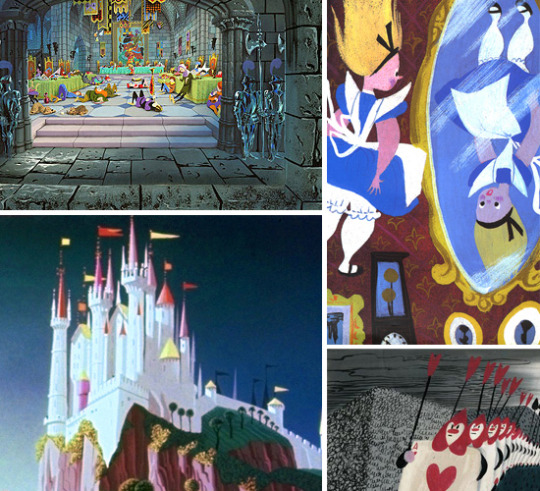
Walt wanted to make a feature that took the pop artistry of their designs and made the animation work for it instead of the other way around – which brings us to another animation studio that was doing well at the time, United Pictures Animation, or UPA.
UPA didn’t have the kind of budget Disney normally had for their animated projects, but what they lacked in fluidity they made up for in style. Watch The Tell-Tale Heart, Gerald McBoing-Boing and Rooty-Toot-Toot to see what I mean. UPA were pioneers of limited animation, taking their scant resources and creating some striking visuals with bold geometric designs. Through this, they defined the look of 50’s animation. Though perhaps unintentional, Sleeping Beauty comes across as Disney’s response to UPA, or what would happen if UPA had the funds they deserved. The characters’ contours are angular but effortlessly graceful, defining their inherent dignity and royalty. And the colors, ohhh the colors…
Because of the immense amount of work required to animate in this difficult new style (and in the Cinemascope ratio, no less) as well as story troubles and Walt barely supervising the animation studio now that he had his hands full with live-action films, television, and a theme park, Sleeping Beauty had a turbulent production that lasted the entirety of the 1950s. For a time, Chuck Jones of Looney Tunes fame was set to direct. Director Wilfred Jackson suffered a heart attack partway through production and Eric Larson, one of the Nine Old Men, took the mantle from there before Walt Disney replaced him Clyde Geronimi. And even after that, Wolfgang Reitherman teamed up with Geronimi as co-director to get the film finished after no less than three delays. Also, Don Bluth got his foot in the door as an assistant animator for this feature, beginning his short-lived but impactful tenure at Disney. Did all this hamper the movie, or did they succeed in what they set out to accomplish?
Well, one of the reasons why this review took so long was because I had a hard time not repeating “MOVIE PRETTY” and “MALEFICENT AWESOME” over and over. Make what you will of that.
The story begins as most fairy tales do with your typical king, Stefan, and his queen suddenly blessed with a baby girl after years of wishing for a child. They christen their daughter Aurora (middle name Borealis, localized entirely within their castle) and throw a huge celebration in her honor. People come from all over the kingdom to pay homage to the princess and OSMKFKSBFHFGILWBHBFC…
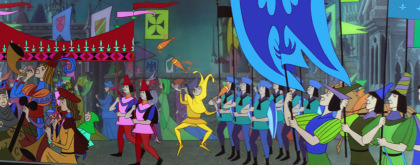
Movie pretty…
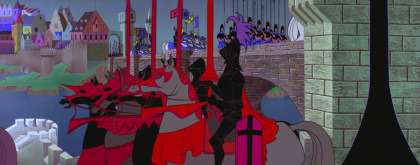
Movie pretty…
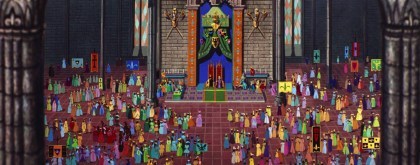
MOVIE PRETTIEEEEEE…
John Hench, Academy Award-winning special effects man and art director, turned Walt on to the idea of basing the look of Sleeping Beauty on classic medieval artwork. Thanks to him and Eyvind Earle’s insanely detailed designs and backgrounds, this is one of Disney’s most visually distinct and beautiful films. A single still from this feature wouldn’t feel out of place up in The Cloisters.
Among the party guests is King Stefan’s old friend King Hubert (Bill Thompson) bringing his young son Prince Philip. Stefan and Hubert wish to unite their two kingdoms and formally announce Philip’s betrothal to the infant Aurora.

“We were going to do it during the second trimester, but we decided to wait until she was more mature.”
By the way, your eyes are not deceiving you. That is Aurora’s mother, Queen Leah, alive and well and named. And frabjous day calloo callay, she even gets some lines! The most common joke about Disney princesses is that they don’t have moms (even Ralph Breaks The Internet went out of its way to highlight that), so as a hardcore Disney fan who often has to put up with this generalization, Leah’s existence leaves me feeling vindicated.
Once that happy revelation is out of the way, we’re introduced to our main protagonists.
Oh, you thought I was referring to Philip and Aurora? Nonononono, my friends. THESE are the true heroes of Sleeping Beauty, the Three Good Fairies.

The fairies started off as one-note side characters sharing the same personality. Think pre-Ducktales-reboot Huey, Dewey, and Louie in dresses. But the studio had a difficult time giving Aurora more depth and was having a lot more fun developing the fairies. Naturally, they became so fascinating and appealing that more screentime was given over to them. Now the story’s carried by three wonderfully fleshed out ladies who are distinct in both looks and personality: Flora’s the pragmatic tradition-adhering leader, Fauna’s the sweet scatterbrain who mediates, and Merryweather’s the feisty young upstart.
With the plot now focused on characters who held a traditionally minor role, it’s easy to read this as a perspective-flipped version of the fairytale, but there’s more to it than that. Remember in my Clash of the Titans review how I mentioned the gods literally play chess using the heroes as pieces? I tend to view the main conflict of Sleeping Beauty in the same way. The Three Fairies and Maleficent are in a constant game of good vs. evil, moving Aurora, Philip, and the rest of the royals as pawns in their plans. There’s plenty of plotting and intrigue, with both sides constantly guessing and second-guessing the other’s next maneuver, and even if you’re already familiar with the story’s trajectory you’re still left on the edge of your seat as it inches towards the fiery climax.
And dare I say it but…the fairies and their power dynamic make this Disney’s most feminist film. Yes, really. You could argue that some of the other animated movies from the Renaissance and Revival period have more notable, stronger female protagonists, and many of the live-action remakes try to be woke without really grasping the concept, but consider this: The cast of Sleeping Beauty is mostly female, the leads aren’t objectified in any manner (that is if you count Aurora as a supporting character), nor does their gender factor into their competency, each one differs in age and body type, and most of them are working together towards a common goal as opposed to against each other. Name a movie in the past decade that does the same and still manages to be entertaining (no, really, I’d love to see it). There’s even one scene that unintentionally provides great commentary on the divides in the feminist movement, but more on that later.
Flora and Fauna bless the baby with beauty and song respectively which are accompanied by a short chorus and some sumptuous graphics. I don’t think I need to reiterate that when this movie goes extra with the visuals, it GOES EXTRA with the visuals. Next comes Merryweather with her gift. To this day, no one knows what Merryweather intended to give Aurora. Flora’s the most traditionally feminine of the three so her giving Aurora beauty comes as no surprise. By comparison, Merryweather is the most forward (or unconventional, depending on your point of view). I wouldn’t put it past her to favor Aurora with intelligence, or humor, or passion, or creativity or humility or confidence or decisiveness or physical fitness or great swordsmanship or telekinesis or ice powers or one million YouTube subscribers or comfort in her female sexuality.
Me personally, I think I’ve got the best gift of all:
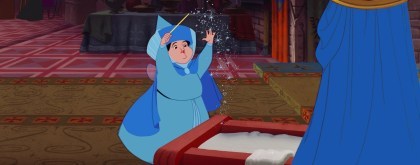
“O Princess, my gift shall be…getting all reviews posted on time for once!”
Alas, before Merryweather can bestow such a wondrous quality upon the child, she’s interrupted by a horny party crasher.
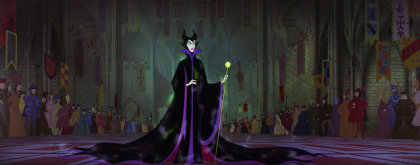
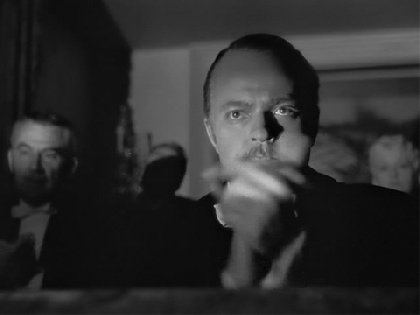
Maleficent. The Mistress of All Evil. Chernabog’s right-hand witch. The Disney villain all Disney villains strive to be. She has it all – the looks, the poise, the power, the laugh, the cunning, the ruthlessness! She doesn’t even need to sing a song because she’s already awesome enough without one. Marc Davis’ gothic design cuts a fine figure and Eleanor Audley’s subtle icy voicework is trés magnifique. As much as I enjoy Audley as Cinderella’s evil stepmother, Lady Tremaine was but an appetizer in comparison to the four-course banquet of pure villainy that is Maleficent.
This leads to a small point of contention some viewers have with Maleficent in spite of hitting top marks elsewhere: her motivation. Putting a hit out on a child for not getting invited to a measly party? Not exactly compelling, is it? And yes, it isn’t a deep motive…is what I would say if I wasn’t well-versed in folkloric tradition. In the original fairy tale and the movie (though it isn’t outright stated in the latter), the party for Aurora isn’t just your average royal kegger, it’s a christening. Back in ye olden days, christenings were very big deals. To not receive an invitation to one was a grave insult, so not extending an invite to your semi-omnipotent magical neighbor is just asking for trouble. In the fairy tale’s defense, no one had seen the evil fairy for years and assumed she was dead, though I can’t imagine how nobody thought Maleficent wouldn’t find about it eventually.

“You dare to deny me, foolish mortals? Very well, then! I shall have my own christening! With blackjack! And strumpets!”
Maleficent is proof that sometimes you don’t have to have an elaborate backstory, a god complex, a tragic past or the unfortunate luck to be on the wrong side of a conflict. Sometimes all you need is some magic, brains, class, and a whole lot of flair to be a perfect, intimidating, and unquestionably iconic villain.
Basically what I’m saying is these movies never happened. Got it?
Maleficent is disarmingly polite over being snubbed, even after Merryweather bluntly tells her nobody wanted her to come. She even brought her own gift for the baby – sixteen years of life cut short by the prick of a spinning wheel spindle, because why change into a dragon and destroy everyone all at once when you can draw the torture out over an agonizingly long time and deliver the coup de grace in the prime of a young woman’s life? That’s how Maleficent rolls, baby. She could dole out capital punishment when she has to without batting an eyelid, but causing human suffering is her bread and butter.
Stefan begs the fairies to undo Maleficent’s curse, but it’s too strong for them. Flora and Fauna insist, however, that Merryweather can use her gift to lessen the spell’s potency. Now instead of dying from that fatal prick, Aurora will sleep until she receives True Love’s Kiss™. Stefan’s not one to throw caution to the wind though, so he orders all of the kingdom’s spinning wheels to be burned in the meantime.

I just pray his kingdom’s economy wasn’t based on textiles otherwise they’re screwed.
As the peasantry celebrates Guy Fawkes Day several centuries early, the fairies ponder their next move. They’ve been around long enough to know that removing spinning wheels from the equation won’t put a damper on Maleficent’s scheme. This scene is incredibly effective in establishing two things:
Maleficent’s near-omniscient presence in the film
How well the fairies’ differing personalities play off each other
Maleficent rarely miscalculates her opponents, and that guile puts her one step ahead of the heroes, making her one of the few Disney villains to nearly reach their goal. The only mistake she makes in the entire movie is trusting her henchmen to do their jobs when she isn’t directly supervising them, though that’s more on them than her. The different methods the fairies propose to deal with Maleficent fantastically illustrate what kind of people they are. Fauna believes she’s just a miserable soul who could be reasoned with if they talk things over. Merryweather would rather take the fight to Maleficent and turn her into a toad. Flora, however, is wise enough to know Maleficent’s too wicked to plead to, too clever to bargain with and too strong to face head-on, so their best course of action is to focus on protecting Aurora through any means necessary. Her initial idea is to enchant the princess into a flower (her namesake is her specialty, after all), but Merryweather reminds her that Maleficent enjoys creating bitter frosts just to kill her flowers.
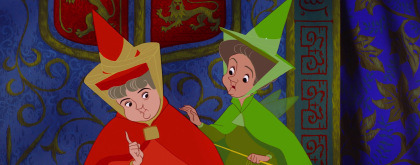
“Well we could try that but stick her in a castle with a beast for a while…nah, that’ll never work.”
Yet never one to give up, Flora alters the plan so they’ll raise Aurora as a peasant girl out in the woods. This means disguising themselves as humans and giving up magic for sixteen years so as to not attract Maleficent, but that amount of time is like twenty minutes to the fair folk. Stefan and Leah reluctantly agree to the plan, and the fairies spirit little Aurora away from the castle that very night.
Sixteen years later, Maleficent is infuriated that her minions have failed to locate Aurora, even more so when one reveals that they’ve spent the whole time looking for a baby instead of a maturing woman. In an interview with the Rotoscopers podcast, Don Bluth called Maleficent a very flat antagonist because she surrounds lackeys dumber than her so she could be the smart one among them and, again, her supposed lack of motivation. But come on, let’s not entirely condemn the bad guys for having too much faith in their underlings. It’s difficult to find minions smart enough to carry out orders but dumb enough to stay unquestioningly loyal. Usually you have to register as Republican in order to get some.
Maleficent gets her anger out in the most therapeutic way – throwing lightning bolts at her orcs, awesome – then leaves the job of finding Aurora up to her trusty raven Diablo. We then finally see the grown-up Aurora herself, whom the fairies renamed Briar Rose as a nod to the Brothers Grimm version of this tale.
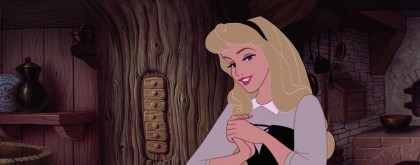
I know I’ve made the occasional case for the princesses from Walt’s era compared to the present day, and yet I have a hard time defending how…I don’t want to say bland. Bland would mean there’s nothing interesting about Aurora, and that’s a lie. She’s gorgeously designed and drawn, and even in her peasant dress she has an air of elegance and sophistication. She carries herself like a queen; her innate royalty reveals itself in her graceful movements. Mary Costa also gifts her with an excellent set of pipes. Hearing her song echoing through the forest is nothing short of magical. She’s a flower child who can talk to animals. She has dreams of escaping her adopted aunts’ loving but stifling care and being allowed to grow up, see the world, actually talk to people, and even find a life partner. She has some strong potential. It’s not that Aurora’s boring, she’s just not quite as developed as we’ve come to expect our animated female protagonists to be. I’m grateful for what we’ve got, but I only wish we could have more. What was her childhood like? How did she learn to communicate with animals? When did the fairies trust her enough to let her spend time out on her own? Did the fairies ever subtly teach her lessons in royalty through lessons and games? Heck, nobody bothers to keep her informed about Maleficent or her curse, and they act surprised when she’s shocked to learn she was a princess the whole time. I want to see what Aurora could have been like if she had known the truth already and what kind of steps she would take to defend herself. Blame the source material for this; it’s difficult to write a compelling main character when she’s supposed to sleep through most of her story.
The fairies send Aurora on a fetch quest so they can plan a surprise birthday party for her. Merryweather wants to bring their magic wands back out for the job, but Flora insists on taking no chances now that they’re in the home stretch. Fauna gets to live her dream of baking an elaborate cake (it’s thanks to her referring to a teaspoon as a “tsp” that I do it too), and Flora insists on making Aurora a gown fit for a princess using Merryweather as a dummy. And we also get one of the best burns in the Disney canon:
Merryweather: It looks awful!
Flora: That’s because it’s on you, dear.
youtube
The fairies fall into reminiscing over raising Aurora and get teary over having to let her go soon. I see where they’re coming from, they’re the ones who raised her for sixteen years. They must have so many fond memories, not to mention they put all that work into learning to properly raise a child let alone live like normal human beings seeing how two of them still can’t sew or cook without magic. I wonder what that was like –
No, NO, you CGI abominations DO NOT exist! Go back to the fires from whence you came!!
“Ugh, I’m gonna need something strong to expunge that from my eyes.”
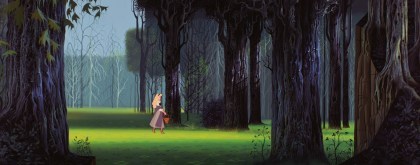
There we go.
Aurora wanders through the forest, drawing out the usual bevy of cute woodland critters with her singing. She also catches the attention of a grown-up Prince Philip (Billy Shirley) who’s more dashing and considerably less blonde than he was sixteen years ago.
By this point, the Disney animators were far more confident in their ability to draw realistic but expressive leading men, hence Philip’s expanded role from the story. He’s also the first Disney prince to have a personality; not a terribly deep or defined one, but it’s a step up from his nameless plot-device predecessors. There are some signs of him being a hopeless romantic, he gets a few funny lines here and there, has a sturdy friendship with his horse Samson, and is fiercely determined when it’s time to kick some ass. He does have the same problem as Aurora in he randomly decides to stop talking for the rest of the movie once he reaches the midway mark (at least Aurora has the excuse that she’s sleeping for that remainder), but I suppose you could chalk this up as to him wanting to spite Maleficent with his silence.
The animals steal some of Philip’s clothes so they can pretend to be Aurora’s dream prince. Aurora plays along as she sings the movie’s standout song, “Once Upon a Dream”. Philip and Samson watch until he smooths his way into the dance. Once Aurora discovers the switch, Philip gets a little too up in her personal space for my liking, constantly grabbing her hand so she doesn’t run off and pulling her closer to him. Not as horrible as what the prince does to the sleeping princess in the original story (a questionably consensual kiss is a trifle compared to how the scumbag of a prince treats her there), but still a bit iffy.
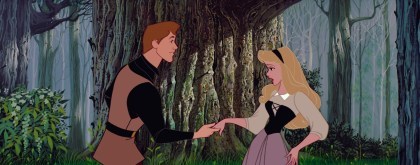
“It’s a good thing my aunts taught me to never go anywhere without a loaded pistol taped to my back.”
But once Philip backs off a little and joins in her song, they both dance together and OEHSGBJSGBLL…

I think I’m going to need surgery to get my jaw off the floor back into its proper place thanks to this movie.
As per Disney tradition, Aurora and Philip’s waltz means the two are head over heels in love with each other. But when it comes time to finally exchange names, Aurora panics and runs away, though she sticks around long enough to tell Philip to meet her family at the cottage that evening.
Back at home, the party preparations aren’t proceeding as planned. Flora’s dress looks as good as my attempts at dressmaking, and Fauna’s dessert wouldn’t feel out of place on Cake Wrecks.
A fed-up Merryweather reads Flora and Fauna the riot act and convinces them to finally take up their wands again. This produces more desirable results, though Merryweather still gets stuck with cleanup duty.
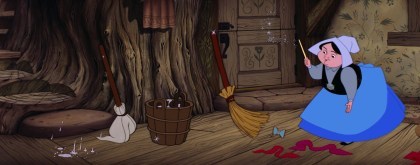
Enchanting a broom to come to life and do your dirty work? I don’t see this going wrong in any possible way.
Things start to go south when Flora and Merryweather argue over the dress color and it escalates into a full-blown wizard’s duel. This gag was supposedly based on the animators’ arguments over what was Aurora’s proper dress color. I think they should have compromised and combined both colors to make purple, which would go lovely with Aurora’s violet eyes, but what do I know. I’m just the illustration major writing a blog. Unfortunately, while the fairies remembered to cover every door, window, and crack that could expose their magic, they overlooked the fireplace. The sparkly residue of Flora and Merryweather’s fight fly up the chimney, alerting Diablo to their hideaway.
Going back to what I said earlier about this movie providing some commentary on feminism, consider this: Flora is obsessed with pink, a traditionally female color, and she gives Aurora an attribute that is oft preferred in a woman but not the most important quality, beauty. Merryweather, on the other hand, is all about blue, a color usually geared towards boys, and she has much more common sense and practicality about her. Though Merryweather and Flora are able to put aside their differences in personalities and approaches for a common goal, it’s when they refuse to compromise and begin prioritizing which color – ie. which ideology and extension of themselves – that they want Aurora to step into that they lose sight of what’s important, and allow everything they worked for to collapse on itself. It’s played for laughs very well, sure, but if not’s symbolic of the dichotomy between traditional femininity and modern sensibility that tears apart the feminist movement then I don’t know what is.
The fairies manage to fix their messes in time for Aurora’s return. She’s thrilled with their gifts but shocks them all when she announces her new boyfriend is coming over for dinner. They come clean about her heritage and betrothal to Prince Philip, and Aurora runs up to her room in tears over the fact that she’ll never see her one true love again. That and her entire life has been a lie and she’s being carted off to meet parents she knows nothing about to marry a man she’s never met and rule an entire kingdom with no prior experience or knowledge. But mostly the true love thing.
Meanwhile, Stefan and Hubert are making wedding plans over wine with “Skumps”, the preferred toast between me and my friends. Also adding to the humor is a minstrel who keeps stealing sips until he literally drinks himself under the table.
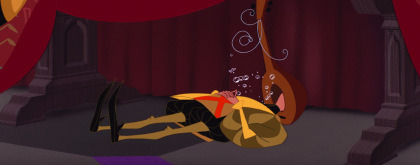
This was also his way of getting through the Black Plague, co-opted by the rest of the world six hundred years later.
Philip returns and Hubert goes to greet him. He thinks his son is thrilled at the prospect of marrying Aurora but is disappointed to learn that he’s fallen for an anonymous peasant.
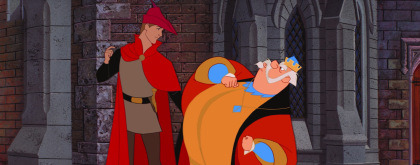
“At least tell me if she’s royalty in disguise so you don’t elope to Sicily!”
Philip rides back into the woods for his big date, leaving Hubert with the unenviable task of breaking the bad news to Stefan. As for Aurora, the fairies smuggle her into the castle and prep her for her homecoming. She’s still blue over having to ghost her forest hubby though, so the fairies give her some time to herself.
Biiiiiiiiig mistake.
So imagine you’re me, growing up watching this movie on tape on a television set with a very standard but not spectacular sound system. Then years later you download the remastered soundtrack and give it a listen while you’re falling asleep. You’ve got the whole score memorized, the volume is nice and low, it’s all good.
And then, just as you’re drifting off, you hear a ghostly voice singing in your ear “Auroraaa…Auroraaaaa…”

That reminds me, I haven’t had a chance to talk about the music yet, haven’t I? Forgive me for waiting so long to do so but my reaction to it is equivalent to the visuals. The score is taken straight from the Sleeping Beauty ballet by Tchaikovsky, the same composer as The Nutcracker, and it is lush, sweeping, sumptuous, just…

While George Bruns was mostly faithful with how the score was represented within the context of the ballet, at certain points he took the same approach as The Nutcracker Prince and rearranged the music order to underscore totally different scenes to staggering effect. The beautifully ominous music where Maleficent appears as a ball of green flame and leads the hypnotized Aurora to her doom? It’s from one of the ballet’s divertissements where Puss in Boots dances with his girlfriend. But tell me which is more fitting for a musical composition such as this – two cats pirouetting around each other in a crowded ballroom, or eerie pitch-black spiral staircases illuminated by green fire as a cursed princess inches closer to her dark destiny against her will?
youtube
The fairies realize their error and frantically search the maze of secret passages for Aurora. Though the princess resists Maleficent’s commands for only a moment, they are still too late to save her from fulfilling the curse. Maleficent gloats and leaves the fairies to wallow in their failure. It’s made even worse as the merrymaking from the oblivious revelers below ring out while they put Aurora to bed in a tower and mourn over her. It’s heartbreaking: they raised and loved her as if she were their own daughter, and they still couldn’t protect her. Everyone talks about “Baby Mine” and Bambi’s mom as huge tearjerkers, but why is this scene constantly forgotten?
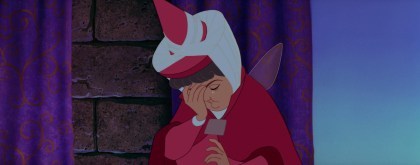
Stupid onions, stupid stupid onions…
Fauna and Merryweather can’t even begin to imagine how heartbroken Stefan and Leah will be, but Flora has a solution: put the kingdom to sleep along with Aurora until she is woken up. I understand her wanting to spare Aurora’s family some pain, but conking out an entire principality for god knows how long to cover up their failure? AND at a time when Europe was all about invading and conquering itself? Are we sure this isn’t just part of Maleficent’s overarching plan for revenge? This sounds more like something she would come up with instead of the leader of the good guys.
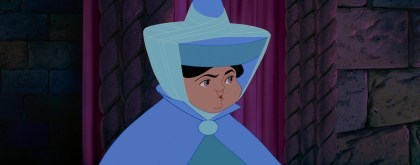
“So what happens if one of the neighboring kingdoms decides to attack while everyone’s sleeping?”
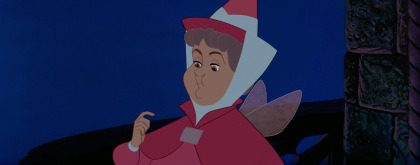
“Then we’ll put them and their armies to sleep, too.”

“And once Aurora is saved, both kingdoms will immediately wake up to find themselves thrust into a war they’re barely prepared for, is that correct?”

“Oh, you’re right, that’s a terrible idea.”

“Finally, thank you.”

“I’ll just turn them all into flowers.”

“THAT’S NOT AN OPTION!!!”
The fairies flitter about the castle grounds spreading their spell over the unwitting royal court, even putting the candles and sconces out. We have another reprise of the “Gifts of Beauty and Song” chorus now altered to sound like a lullaby, providing an interesting bit of symmetry between it and its earlier use in the film. Whereas it first underscored their blessings upon Aurora, now it plays as the fairies are giving the “gift” of sleep to the entire castle.
While Flora knocks out the throne room, she overhears Hubert muttering about Philip eloping with a peasant girl and she makes the connection. The fairies speed to the cottage just as Philip arrives there. But once again Maleficent beats them to the punch. Her goons ambush Philip and she watches them wrestle and bond him with fiendish glee.

You magnificent, kinky bitch.
Maleficent was only out to capture the one man who could break Aurora’s curse; the fact that he’s really the son of her nemesis’ allies is just icing on the cake. Flora, Fauna, and Merryweather resolve to rescue him from Maleficent’s fortress in the Forbidden Mountain.
Some movies reach the brink of greatness only to falter when it comes to the final act. Sleeping Beauty is not one of them. Everything that happens from the moment we slowly zoom in through the purple mist on to the Forbidden Mountain itself up until the storybook closes is perfection. The perfectly paced action, the animation, the music, Maleficent’s hideaway in all its decaying glory (I swear it’s like Jean Cocteau meets Frank Frazetta meets Giotto) all make for the climax of climaxes.
The fairies shrink to insect size and silently sneak through Maleficent’s creepy domain, narrowly running into guards and gargoyles at every turn. They traverse the stronghold until they find her overseeing a hellish bacchanalia in honor of her supposed victory.
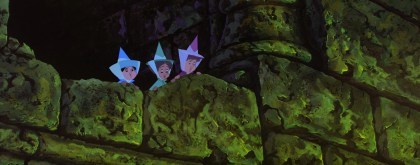
“My old gaffer would have a thing or two to say if he could see us now.”
Soon Maleficent gets bored and goes to “cheer up” her captive. Then we have it: The Moment.
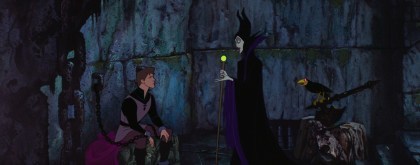
I’ve talked about this before, that one small, devious step further the villain takes to make themselves more heinous in our eyes. It’s the Wicked Witch taunting Dorothy with visions of Aunt Em. It’s the Beldam hanging Other Wybie’s remains. It’s virtually everything Heath Ledger’s Joker does. And it is this simple scene where Maleficent details what she plans to do with Philip. She spins “a charming fairy tale come true” of Aurora sleeping without aging, waiting for her prince to come to wake her. And Philip will escape the dungeon, ride to her rescue and prove true love conquers all – in one hundred years, when he’s a broken old husk of a man on the brink of death. DAMN. If you want to know why Maleficent is considered the best of all the Disney villains, it’s not just all her previously praised qualities, it’s her sheer sadism and the pleasure she takes in it.
The fairies enter and free Philip once Maleficent departs. The course of true love never runs smoothly though, so they arm him with the Shield of Virtue (licensed by Carefree Maxi-Pads), and the Sword of Truth to aid in his escape.
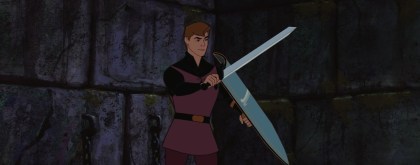
“So, why’s it called the Sword of Truth?”
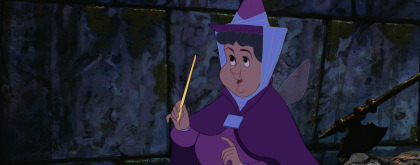
“Anyone who’s subjected to it speaks only the truth…as they bleed out and die, of course.”

“Cool, cool. On an unrelated note, I think I’m gonna go to DC for my honeymoon.”
Diablo sounds the alarm and the Battle With the Forces of Evil kicks off with Philip slashing his Sword of Truth through Maleficent’s goons.
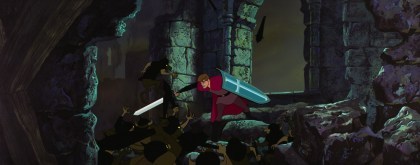
“I steal lunches from the break room fridge!” “I broke wind last Tuesday and blamed it on the dog!” “I cried like a little girl during The Good Place finale!” “I only wash my hands for NINETEEN seconds at a time!”
Philip makes his getaway on Samson and the music reaches truly operatic levels as Maleficent does everything in her power to end him. Yet Philip soldiers through it like a boss. Crumbling mountainsides, Maleficent hurling lightning from the sky and summoning a forest of thorns to block the way? Fuck that shit, he’s gotta go save his girl.
Then, as Philip cuts his way through the briars, Maleficent looks at her watch, realizes it’s No More Fucking Around O’Clock, zooms over to the castle, throws down the most intimidating challenge ever –

“Now you shall deal with me, O Prince, and all the powers of HELL!!”
– and with that, she takes her final form: a massive fire-breathing dragon.
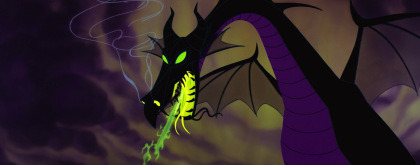

Every Disney villain who’s gone kaiju in the final act owes everything to this gorgeous terrifying beast. The dragon is an awe-inspiring unholy fusion of style, power and darkness. There’s a reason why she’s the final boss in Fantasmic; the chance to watch a live dragon battle is too cool to pass up.
Speaking of battles, Maleficent’s dragon form was animated by Woolie Reitherman, who previously brought us such gargantuan monster clashes as the T-rex brawl in Fantasia and the escape from Monstro The Whale in Pinocchio. And when you have a dragon confronting a fairytale prince, well, you know what’s coming.

Maleficent backs Philip on to a cliff surrounded by flames, leaving him only one desperate shot. With a little extra magic from the fairies, he throws his Sword of Truth at Maleficent and it plunges right into her heart.
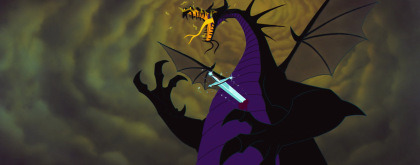
“I liked…Frozen 2…more than the first one…”
Maleficent’s spells die with her, clearing the way for Philip. He gives Aurora that wake-up smooch and everyone in the castle slowly rouses, owing their inexplicable simultaneous twenty-minute blackout to the unusually strong wine.
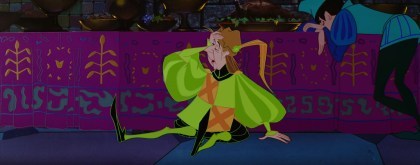
He can attest to that fact.
The royal families are happily reunited, and the film ends on Flora and Merryweather fighting over Aurora’s dress color yet again as she and Philip waltz together on the clouds using animation Beauty and the Beast would borrow thirty-two years later.
Sleeping Beauty is a movie I can never have on in the background because the moment I look up from my work I am spellbound by it. Do I need to elaborate on how this is one of the most beautiful looking and sounding movies Disney’s ever produced? Sleeping Beauty is the swan song of Disney’s first golden age of animation. For better or for worse, their animation process would switch to the rough, cost-cutting Xerox process starting with their next feature, 101 Dalmatians, and few films would reach Sleeping Beauty’s level of gorgeousness ever since.
Though a massive financial and critical hit on release, it wasn’t enough to make up for the monstrous production costs, not unlike Fantasia. Thankfully, home video sales revived interest and made it Sleeping Beauty of the top-selling VHS tapes of the decade, cementing it as a bonafide classic. It’s one of my favorites from Disney for its stunning visuals, gorgeous music, phenomenal villain and overlooked but great cast characters. Revisit it if you haven’t already.
Thank you for reading! If you enjoyed this review, please consider supporting this misfit on Patreon. Patreon supporters receive great perks such as extra votes for movie reviews, movie requests, early sneak-peeks and more! Special thanks to Amelia Jones, Gordhan Rajani and Sam Minden for their contributions!
Artwork by Charles Moss.
Screencaps from animationscreencaps.com
March Review: Sleeping Beauty (1959) Whenever I discuss Sleeping Beauty with someone who doesn't share my enthusiasm for Disney, they have an irksome tendency to get it muddled with Snow White; their excuse being "it has the same plot".
#2D animation#angelina jolie#animated#animated feature#animated movie#animated movie review#animated musical#animation#animator#animators#anthropomorphic animal#aurora#ballet#barbara luddy#battle#battle to end all battles#battle with the forces of evil#bill shirley#bill thompson#blue#briar rose#cake#charles perrault#classic disney#curse#diablo#Disney#disney animated#disney animated feature#disney animated movie
29 notes
·
View notes
Text
@big-block-of-cheese-day writes about an alleged lack of good advice for young men struggling with sex, dating, and life in general:
You know who does make an effort? MRAs. PUAs. Jordan Peterson does really project that he wants you to be successful. Aww hell, incels spend most of their time convincing each other that they belong in that particular mental hellhole. They are the gray body wash bottles of the advice world… and they suck. Not because advice for boys and young men has to suck, but because the market leaders are unchallenged for structural reasons.
There’s a market out there. But any moderate man with good advice and the willingness to put his name on it is signing up for a tightrope walk. Internet critique is the art of uncharitable interpretation.
This idea, that it’s impossible for anyone to give honest, useful advice about women to nerdy young men on the internet, is a recurring theme in his writing. And he’s far from the only one.
These guys seem to be stuck in a bizarre mental prison where they know they need advice, they can recognize that all the advice deemed acceptable within their sphere is useless to them, but they don’t notice that the social forces doing the deeming are part of the problem too.
There are tons of guys on the internet giving out solid advice on meeting women to awkward nerdy guys. Antonio at Real Men Real Style, Aaron at Alpha M., and Myke at Social Confidence Mastery each have a bunch of videos on youtube on this topic. Myke in particular, being an entrepreneur, figured out that there are a lot of nerds with high-paying tech jobs who are dying of romantic isolation, and has done well serving that market. Granted, I don’t actually watch these videos, I just happen to know Antonio from way back and met the other guys through him. Their success, and the success of a lot of other guys in this market, tells me that they’re doing something right.
Knowing these guys, and seeing the success they have with their millions of youtube subscribers and full-time careers in “Men’s Lifestyle” internet content, BBOC’s list at the beginning of the quote looks like an army of strawmen. If one replaces Jordan Peterson with internet feminists’ caricature of Jordan Peterson, I agree that everyone in the list sucks. So why is this the list?
The nerdcels who have the problems BBOC describes have figured out that the only useful dating advice in their silo of the internet is for women. Maybe the bad advice for men is just there because the writers are dumb, or hate men, or something. More likely, the advice for men is for women, too!
There are two separate reasons I can think of why websites for nerdy feminist chicks would have bad advice for men. The first is the enforcement of normative femininity: calling out various masculine behaviors as problematic is a sneaky way to remind women that it’s bad for them to be masculine, without actually having to endorse traditional gender norms. The second is warning women of the dangers of other men, to deter them from venturing too far into the wild.
Starting from the premise that gender roles are evolved, near-optimal solutions to eternal problems originating in biology, it is not surprising that as more women have rejected traditional femininity, a discursive technology has arisen to keep them behaving while pretending to do something else. Nor is it surprising that the collateral damage of men taking this discourse seriously falls upon some of the most isolated, vulnerable men.
1 note
·
View note
Text
@beenpole asked: 💅 Job
HEADCANON MEME. accepting


How does your muse feel about gender roles? Do they conform to them, or do they play by their own rules?
for him personally, he doesn’t really challenge a lot of gender roles, nor does it occur to him if he is or isn’t fulfilling them. i will say he doesn’t subscribe to the whole concept of how a man and woman should be when in a relationship, since he really isn’t at all the type to try and fill the traditional authoritative role when he’s with a woman. he’s personally pretty individualistic, and generally feels everyone should be this way, as far as behaving and doing as you please and think is right, as long as it isn’t hurting anyone unnecessarily.
i wouldn’t describe him as very traditionally feminine, nor is he really a macho type. he’s secure in his masculinity, and cares a good deal about his appearance, despite feeling like he isn’t very attractive. his most “feminine” quality is probably how much time he spends on his hair every day.
#about: job.#i had to think abt this a lot cause i was like#what even IS femininity/masculinity.....
0 notes
Text
since apparently theres no consequences for delivering unto this website extremely long and good takes i will present to you my hot take on the ace d'escourse, with no sources because I Dont Feel Like It. its more words than is reasonable bc i have been stewing in this for like 4 years and if i dont type it out at some point im going to fucking lose it. no, literally, it’s 3 pages long in word about shit no one cares about anymore. please remember to like and subscribe.
some background on me, i id’d as ace for something like 8 years, from the first time i read the wikipedia page on it back in maybe 2009 or thereabouts. i also id’d as aro for about a year in 2016. that is to say, i have a lot of compassion and understanding for asexual individuals and feel i understand the inclusionist side of the argument pretty well, as i never questioned inclusionism until maybe 2014 or so, when the discourse blew up. i took some time off tumblr because i was so fucking distraught to think that, as i id’d as aroace at the time, that i had to come to terms with not being lgbt. lol i was a little too attached to being ‘gay’ because... fun fact, past dumbass self... you are gay. anyway, i really dont want anyone to feel that i hate them, but after i cooled off a little bit i realized that the exclusionist take on asexuality just makes more sense. hopefully i can explain why clearly enough.
i really believe that what is understood as aphobia is 100% of the time simply a manifestation of our culture’s expectations surrounding sexuality. while “expectations surrounding sexuality” as a very broad topic does indeed cover both the lgbt community and people on the ace spectrum, facing these issues does NOT make a person lgbt. i subscribe to the idea that lgbt is for people targeted directly by homophobia and transphobia. ace issues ARE super important to talk about and the whole inclus/exclus nonsense is entirely because this discourse has been put under the wrong category. im aware that probably most people will not care that much about my opinion on the correct framing of asexual activism as i no longer id as ace but i think this is important for everyone. sexual expectations also weigh on straight individuals, especially women, and i’m going to describe a few examples to try to demonstrate why i believe both that it doesn’t make sense to consider asexuality lgbt as well as why it does make sense to frame it as an issue based mainly in misogyny.
call out post for myself, i use reddit, and i think the r/childfree community is a good example of what i think the framing should be like. although it’s acknowledged that not wanting children has larger social consequences for women, both men and women talk about their issues in the forum, including horrific accounts of reproductive coercion and rape, the intersections with race/being lgbt/ageism (although they could do a LOT better with intersectionality, many posters do touch upon it), profoundly cruel comments made by those who have/want children, difficulty finding an understanding relationship partner, discrimination at work, misunderstandings and even hatred from family and acquaintances, discrimination in healthcare, etc.
i think you can tell where i’m going with this. even though being childfree cuts against the expectations for sexuality in most societies, even though it leads to unfair judgment from others, and even though they face discrimination on the basis of the way they express their sexuality, childfree people do NOT frame parenthood/childfreedom as an axis of oppression, nor do they claim that their lack of desire for children makes them lgbt. it’s not even a question if straight childfree people are straight, because duh? nor if the presence of lgbt childfree people makes the whole community fall under the lgbt umbrella, because it obviously doesn’t.
to drive the point home, the reason why this is NOT an axis of oppression is because parents face a ton of issues as well! they also face reproductive coercion as well as judgment over the number of kids they have, constant scrutiny and moralization over every aspect of their parenthood style, judgment based on parents’ age/wealth/sexuality/marital or dating status/race, housing and employment discrimination, especially for mothers, the government hating poor parents and cutting their benefits, and more i’m sure i’m not thinking of. again, this is due to societal expectations of sexuality. to complete the analogy, people who aren’t ace face their own set of challenges and discrimination. part of homophobia/biphobia is tinged with hatred of our sexual attraction; no one except for straight white men is allowed to really express their sexuality without backlash, and even then there is this shame leading to a lack of proper sex ed and horribly unhealthy understandings of sexual attraction in a large portion of the populace. so calling aphobia an axis of oppression is just not right. and in addition, the large proportion of lgbt aces doesn’t make asexuality lgbt, that’s not how groups work.
some more on what i mean by ‘expectations around sexuality’... in terms of my experience in the US, there is some blueprint in many people’s minds of what a person should be like in terms of sexuality, and that is something like “cishet, abled man, who is neither ace nor aro, who gets laid regularly (but not to excess) starting no later than 18 and ending no later than 28 when he settles down with one cishet abled wife, also neither ace nor aro, who has only had sex with up to three committed boyfriends, and they have precisely two children, approximately two years apart in age, whom the parents can financially and emotionally support to the utmost, because they are also moderately to very well off, and the parents work under traditional gender roles to raise their children as conventionally as possible.” and if you deviate from this script in ANY way that’s viewed with moral panic and scrutiny by someone. and the connection to misogyny is that women are seen as sort of the bastions of sexual morality. we are punished especially harshly for nonconformity.
if you’re poor you’re fucked because either you don’t have kids or you can’t send them off to private schools and feed them fancy organic shit. if you’re lgbt or polyamorous or aro or ace? fucked! if you dare to reproduce as a disabled person, and if your disability impacts your parenthood, especially for women, you’re practically crucified even in liberal circles. if you have too few kids or too many (don’t you know only kids turn out weird? / how can you possibly raise 5 children properly?), if you have too much sex or too little, if you split up the work in your relationship not along gender lines, if you do unconventional things in your parenthood, like accept your trans kids or move a lot or any number of other things, the social judgment rains down like the fires of fucking hell. meaning practically no one can escape it!! huge bonus to the screaming crowd with pitchforks if you’re a person of color or a woman, mega ultra bonus to women of color.
but does that make everyone i just talked about lgbt? no! although every single one of the groups i mentioned is tangentially related through this issue, even though all of them face a lot of horrible problems and discrimination, that does not make those issues inherently lgbt. again, they are tangentially related and i could see a good case for solidarity among many of the groups mentioned; all of them are fighting for greater acceptance of different kinds of relationships, greater acceptance of seeking happiness and being who you are rather than pressuring everyone to conform as much as possible to the LifeScript. but all of those groups are equally related to the lgbt community - that is, tangentially only. just as you can be childfree and straight, a stay-at-home dad and straight, a straight woman of color, so too can you be polyamorous and straight, ace and straight, or aro and straight.
that’s it for my main point. ace and aro people? your lives are hard. i’m not going to downplay it in any way because i know there are a lot of people who actually hate your guts. fuck, i’ve seen people full-on shittalk asexuality, in the internet and real life, in the most blatant of ways, so it’s not just something you can necessarily escape by logging off. not as much so for aro people tbh but i predict as much once the Public gets more wind of your existence. i fully believe that you face a higher risk of sexual assault; discrimination in relationships, housing, and the workplace; horrible comments from everyone who thinks their shitty opinion on your sexuality and love life matters; and I believe you that that hurts and is terrible and that you deserve a place to discuss and provide support.
but. those issues are not exclusive to you. they’re not exclusive to lgbt people, or oppressed people, and so those issues don’t and cannot make you lgbt, nor do they make ace/aro vs. allo an axis of oppression. our communities intersect, yes, considerably, but you are not a subset of lgbt. perhaps our rhetoric can help you, but because straight ace and aro people exist you cannot and should not consider yourselves lgb+. i think you understand that the issues you face are a form of oppression, but they are the result of the toxic and misogynistic sex culture in this society, which, yes, targets lgbt people but also, practically everyone, including groups which are definitively absolutely not inherently lgbt, such as parents, gnc straight people, poc, disabled people, the list goes on.
to conclude, what really converted me to being an ace exclusionist was the example of a straight grey or demi ace. how could you possibly argue that someone who falls in love with the opposite gender only, but with more conditions or less frequently than someone not aspec, is lgb+, can call themselves queer, etc.? exactly what material reality does that person share with a gay or bi person? i think that their issues fall in line with aspec community issues but extremely clearly not at all with lgbt ones.
the end but post script since i brought up orientation modifiers:
perhaps it isn’t my place to say, but i don’t think that microlabels are very healthy and that it would make more sense for the ace community to work on expanding the idea of what sexuality is than to try to create a label to describe every single person’s experience of their sexuality. not that i think you should necessarily kick grey ace people out of the aspec community or that they’re not valid or whatever, but that perhaps it makes more sense to say that some people experience sexual attraction less frequently, and that’s alright. i don’t know.
i spent sophomore year of high school poring over those mogai blogs looking for some new orientation label that would make me go like, oh my god that’s me! and believing that if those labels helped people feel that way they weren’t doing any harm. but what actually finally made me feel like that was expanding my understanding of what attraction is and a better conception of lesbian issues and why i might feel so disconnected from my sexuality and why i might be obsessing over every interaction with a guy looking for signs i was attracted to him but feel super disgusted whenever they exhibited interest in me. i spent so long trying to go like maybe im cupioromantic lithsexual and feeling terrified that that i had such a weird and esoteric sexuality that no one could ever possibly understand enough to be in a relationship with me... like, ok dyke! i know a lot of people have had similar experiences and i don’t think i know a whole ton of people now in college who are still doing that, which makes me think those labels are more harmful than not.
i guess that’s anecdotal but it’s easier for me to believe that a person could cling to those labels due to internalized homophobia than actually have a new form of sexuality heretofore undiscovered throughout all human history, but that’s just me. and so many of them just sound so unhealthy, like dreadsexual. i really wish people would work on expanding what not being asexual can mean and look like and i dont think there would be this drive to create these labels anymore. even demisexual which i think is probably the most mainstream conditional orientation, i think many people who have never heard of it and are perfectly content not to would describe the way they experience sexuality a similar way and just consider it normal. sexual attraction isn’t necessarily having your nethers set aflame upon first making eye contact with someone, it looks different for every person and it’s alright to just be how you are without making it part of your whole identity.
The End II. this is 2,200 words. if you read this far you’re a fucking mad l- *the academy cuts my mic line while looking directly at the camera like in the office*
0 notes